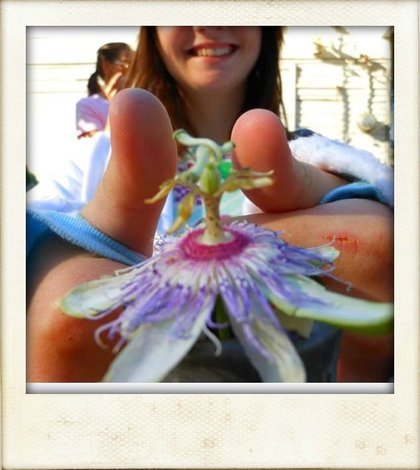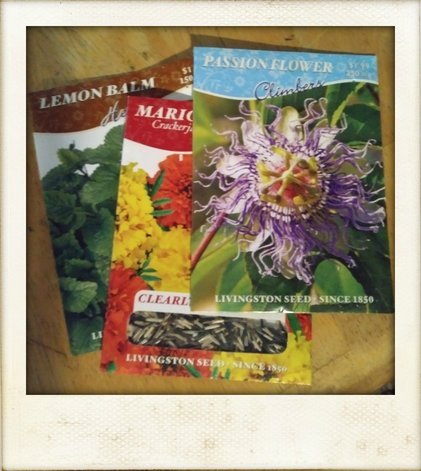Passiflora alata
Passion flower, like every other plant, is known by many names. Apricot Vine, Water Lemon and Maypop are some I've heard. Passion flower earned it's name when Spanish explores discovered it in Peru in 1569. They believed that the flowers represented Christ's Passion and that it was a sign that The Almighty approved of their mission. Drawings and discriptions of the beautiful and uniqe flower were given to a churchman and historian by the name of Giacomo Bosio who, in 1609, wrote that the flower did indeed symbolize the Crucifixion. The Spanish knew the flower as La Flor de las cinco Llagas, or 'The Flower With The Five Wounds.'

Bosio saw many representations of the Crucifixion in the elements of the flower. The petals and sepals represent the ten disciples (minus Judas and Peter) The crown of thorns is represented by the corona filaments. The flower's antlered stamen represent the three nails and five wounds. Once discovered by the Spanish, the plant was introduced to Europe and South America and now grows all over the world.
Passion flower is an unbelievably beautiful flower. But it's value goes far beyond it's beauty. The Aztecs and Incas grew Passiflora alata for both culinary and medicinal use. The flower was believed to treat urinary tract disorders, bone fractures and skin contusions.
But it's also an edible! When you first cut one open, it can be a little intimidating. And a little freaky. I don't have one in hand to show you, but I'll do my best to explain how we eat passion fruit.
1} Cut the top off.
2} What you'll see inside isn't pretty. It's seeds and a membrane. Use a spoon or knife to pull the membrane away from the peel and mix it all up inside the peel.
3} The seeds and fruit inside are yummy, so eat it.
4} Drink up the juice that's left in the peel-cup!
On To The Medicine...
In the late 1800s, doctors in North America recommended the use of Passion flower for patients suffering from epilepsy. By the early 1900s it was being prescribed for anxiety and insomnia around the world. It was available in the States as an OTC sleep aid, but was pulled from shelves in 1978 pending conclusive studies on it's safety and effectiveness.
The Medicinal Power of Passion
Claims of Passion flower's medicinal uses are numerous, many of them resulting from the nervines, or nerve tonics, in the plant. It is often used, and made more effective, in combintation with other herbs and plants. Let's have a look at some claims, studies, and dosage information.
Anxiety
One of the oldest and most common uses for Passion flower is treating insomnia and anxiety.
- According to a University of Michigan Health Library;
"...one study found that a combination of the nervines valerian and passion flower reduced symptoms in people suffering from anxiety. In a double-blind study, 45 drops per day of an extract of passion flower taken for four weeks was as effective as 30 mg per day of oxazepam (Serax), a medication used for anxiety."
The study used herbal suppliments, 100 to 200 mg valerian and 45 to 90 mg Passion flower three times a day.
- The National Center for Complementery and Integrative Health [NIH] reports that in 2007 a couple of "older studies" were reviewed. The studies observed 198 people and compared passion flower with two other drugs and their abilities to reduce anxiety. The conslusion of the review was that the three substances had similar degrees of effectiveness.
Insomnia and Sleep Quality
In a study using "a double‐blind, placebo‐controlled, repeated‐measures design with a counterbalanced order of treatments (passionflower vs placebo tea), separated by a 1 week ‘washout’ period," researchers found that sleep quality was better after drinking Plassion flower tea than after drinking the placebo tea. Sleep quality was measured using sleep diaries that were validated by polysomnograph (PSG).
In a controlled trial comparing the drug zolpidem, otherwise known as Ambien, to passion flower in combination with valerian and hops extracts, in patients who had been diagnosed with insomnia. 78 subjects were given either a dose of the passion flower combination or a standard dose of zolpidem for two weeks. The two treatments seemed to be equally effective.
More
Although the list of conditions that may be relieved to some degree by Passion flower is long, official scientific studies backing up the claims are hard to find.
WebMD lists, as uses for Passion flower
- anxiety
- insomnia
- nervous stomach
- burns
- hemorrhoids
- asthma
- heart problems
- high blood pressure
- seizures
- fibromyalgia
- other conditions
How I Use Passion Flower
Listen up!
This is how I use Passion flower. I'm not suggesting that you use it based on my beliefs, knowledge or experiences. DO YOUR OWN RESEARCH!
Warnings and Precautions
DO NOT use Passion flower medicinally if you are pregnant or breast feeding. Some animal studies have reported that Passion flower may cause uterine contractions.
Passion flower has the ability to thin the blood. If you take any kind of anticoagulant, antiplatelet, blood thinner or have problems producing platelets, DO NOT use Passion flower medicinally.
The seditive nature of Passion flower may potentiate the effects of alcohol and other seditive or hypnotic drugs including benzos, barbiturates, opiates and other downers or depressants. DO NOT use Passion flower if you are on any downers or depressants or if you plan to drink alcohol.
####Passion Flower Tea
To make tea, I pour boiling water over about a teaspoon of the dried Passion flower petals and a couple pieces of the plant's stem. Let it steep for a few minutes. I like to add honey, just because it's yummy.
Passion flower is often paired with other herbs, and I like to pair it up with different herbs depending on what I'm treating.
When I'm having a hard time falling asleep or if I just can't relax, I drink a cup of Passion flower tea. It's also wonderful for helping me chill when I'm just wound up and stressed out!
Passion flower tea on it's own is usually enough to calm my nerves and quiet my mind. I add a little valerian or chamomile if sleeping is the goal!
The calming and sedative nature of Passion flower lends itself to relaxing tense muscles and calming nerves. Combined with it's anti inflammitory properties, a cup or two of the tea can relieve back pain, headaches, cramps, and fibromyalgia.
Passion flower tea can also help balance estrogen levels in the body, relieving PMS symptoms, regulating monthy cycles and in men can boost testosterone levels.
There are a lot of reasons to drink Passion flower tea, but these are the main reasons I drink it. Drink up to 3 cups a day!
More Medicinal Herbs
If you found this article helpful and would like to know about other medicinal herbs, check out my other medicinal herb articles.
Giveaway!

To win this little medicinal seed giveaway, just comment with "Enter me!" and I'll throw your name in a hat and draw a winner after the payout of this post! Good luck!#



